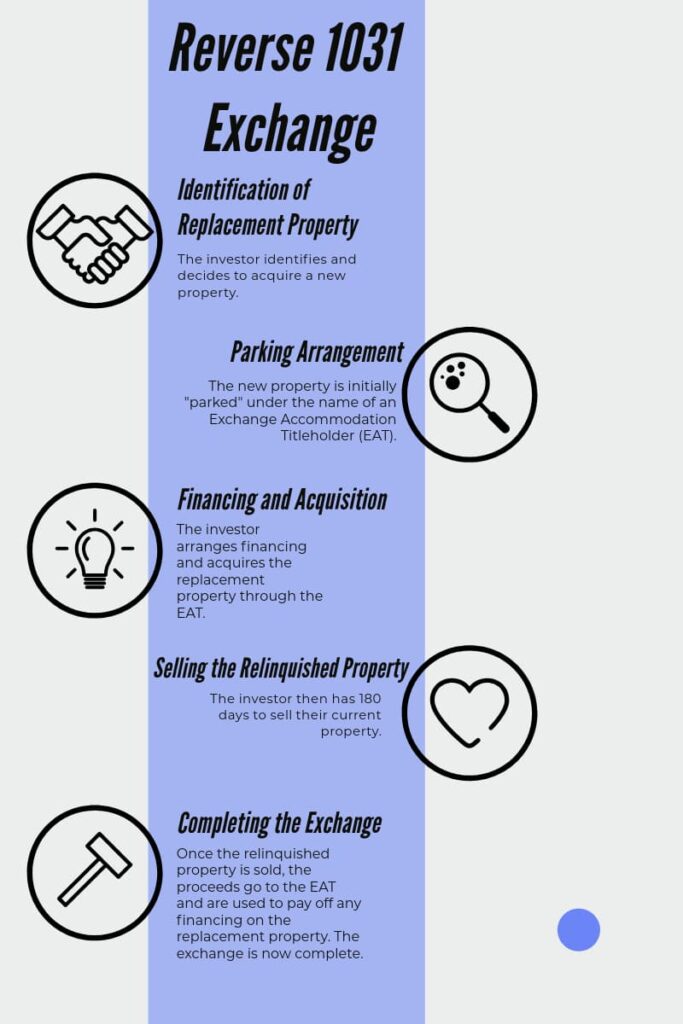In this article we will be discussing the benefits of a DST. This is meant...
Read MoreThe Allure and Complexity of Reverse 1031 Exchanges
In real estate investments, the term “Reverse 1031 exchange” sounds both interesting and complex. It’s a concept that promises financial flexibility but often leaves investors tangled in a web of questions. How does it differ from a traditional 1031 exchange? What are its benefits and risks? Today we aim to demystify the Reverse 1031 exchange, a strategy that can be a game-changer for savvy investors. As we unfold its layers, you’ll discover how it can be a powerful tool in enhancing your investment portfolio, especially in today’s dynamic real estate market.
Understanding the Basics
The Traditional 1031 Exchange: A Prelude
Before diving into the Reverse 1031 exchange, it’s essential to grasp the traditional 1031 exchange. Named after Section 1031 of the IRS Code, it allows investors to defer capital gains taxes on the exchange of like-kind properties. The catch? The replacement property must be identified within 45 days and acquired within 180 days after selling the original property. We have a more detailed blog post with information about 1031 exchanges you can read here.
The Reverse: How It’s Different
In a Reverse 1031 exchange, the order of events is flipped. Here, you acquire a new property (the “replacement property”) before selling the current one (the “relinquished property”). This method offers a strategic advantage, especially in a competitive market where finding the right investment can be challenging.
The Mechanics of a Reverse 1031 Exchange
- Identification and Purchase of Replacement Property:
The first step in a Reverse 1031 Exchange is identifying and purchasing the replacement property. The investor must secure financing and ensure they can complete the purchase before initiating the exchange process. This property must meet the criteria of being like-kind, meaning it should be of the same nature or character as the relinquished property, though not necessarily of the same quality or grade.
- Engaging a Qualified Intermediary:
A key component of any 1031 Exchange is the use of a Qualified Intermediary (QI). The QI is a neutral third party that facilitates the exchange. In a Reverse 1031 Exchange, the QI takes on additional responsibilities, including holding title to the replacement property until the relinquished property is sold. This is known as the Exchange Accommodation Titleholder (EAT).
- Transfer of Replacement Property to EAT:
Once the replacement property is identified and financing is secured, the title of the replacement property is transferred to the EAT. This transfer ensures that the investor does not take direct ownership of the replacement property before the relinquished property is sold, which is crucial for maintaining the tax-deferred status of the transaction.
- Sale of Relinquished Property:
After the replacement property is secured and held by the EAT, the investor must then sell the relinquished property. The timeline for this process is stringent. The investor has 45 days from the acquisition of the replacement property to identify potential properties to sell. Additionally, the entire transaction must be completed within 180 days, meaning the relinquished property must be sold, and the replacement property must be transferred to the investor within this period.
- Transfer of Replacement Property to Investor:
Once the relinquished property is sold, the proceeds from the sale are used to purchase the replacement property from the EAT. The QI facilitates this process, ensuring the transfer complies with IRS regulations. Upon completion, the investor now owns the replacement property, and the transaction is considered complete.

The Benefits of a Reverse 1031 Exchange
Strategic Advantages in a Competitive Market
In a seller’s market, where desirable properties are scarce, a Reverse 1031 exchange allows investors to secure a valuable asset before selling their existing property. This proactive approach can be crucial in high-demand areas.
Tax Deferral and Portfolio Growth
Like its traditional counterpart, the Reverse 1031 exchange offers the advantage of deferring capital gains taxes. This tax efficiency can significantly enhance portfolio growth and investment flexibility.
The Risks and Challenges
Navigating Complex Regulations
The complexity and strict IRS regulations surrounding Reverse 1031 exchanges pose significant challenges. Missteps can lead to hefty tax liabilities. Always seek guidance from professionals who are well-versed and experienced before making any investment decisions.
Financial and Timing Constraints
Reverse 1031 Exchanges are inherently more complex than traditional 1031 Exchanges. The involvement of a QI and EAT, as well as additional legal and administrative requirements, can increase the cost and complexity of the transaction. Investors must be prepared for these added expenses and ensure they work with experienced professionals to navigate the process successfully.
Legal and Financial Considerations
The Reverse 1031 exchange is intricate, involving strict timelines and rules. Legal guidance and meticulous financial planning are indispensable to navigate this process successfully.
Case Study: Success Stories and Cautionary Tales
Successful Acquisition in a Competitive Market
Background: An investor, Jane, was looking to expand her real estate portfolio in a highly competitive urban market. She had her eye on a prime residential property but feared it would be sold before she could sell her existing asset.
Strategy: Jane opted for a Reverse 1031 exchange. She acquired the new property by setting up an Exchange Accommodation Titleholder (EAT) and parking the property under the EAT.
Outcome: Jane successfully sold her relinquished property within the 180-day deadline. The exchange was completed without any tax liability, and she secured a high-value asset that
The Reverse 1031 exchange offers a strategic avenue for real estate investors looking to navigate the competitive market while deferring capital gains taxes. By allowing the acquisition of a new property before the sale of an existing one, this method not only provides investors with an edge but also poses significant challenges. Successful application of this strategy requires planning and professional advice, making it a powerful tool for those willing to use it.
It’s important to note that the information provided in this article is for educational and informational purposes only. Investing in real estate and Delaware Statutory Trusts (DSTs) involves risks, and decisions should be made after thorough research and consultation with qualified financial and legal professionals. This article does not constitute financial or investment advice. Always seek guidance from professionals who are well-versed in DSTs and their implications before making any investment decisions.





